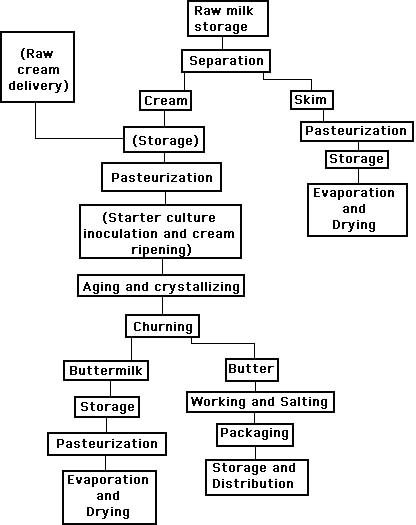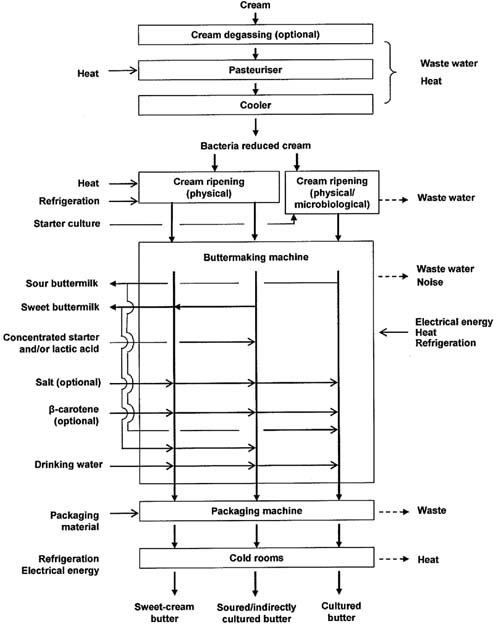Butter production
Back to Information about milk products
I. GENERAL DESCRIPTION:
- 1. Definition
- (Dairy science and Technology, University of Guelph, http://www.foodsci.uoguelph.ca/dairyedu/home.html)
Butter is essentially the fat of the milk. It is usually made from sweet cream and is salted. However, it can also be made from acidulated or bacteriologically soured cream and saltless (sweet) butters are also available.
- 2. (a) Overview of the buttermaking process
- (Dairy science and Technology, University of Guelph, http://www.foodsci.uoguelph.ca/dairyedu/home.html)
Figure 1: Overview of the Buttermaking Process LITERATURE: http://www.foodsci.uoguelph.ca/dairyedu/home.html
- (b) Continuous buttermaking
Figure 2: Continuous buttermaking LITERATURE: BAT for Food, Drink and Milk Industries, June 2005
- 3. Description of techniques, methods and equipment
- (Dairy science and Technology, University of Guelph, http://www.foodsci.uoguelph.ca/dairyedu/home.html)
- General:
- The butter-making process is described in Figure 1.
- The process is basically a mechanical one, in which cream, an emulsion of oil in water, is transformed to water, an emulsion of water in oil. From the aging tank, the cream is pumped to the churn or continuous butter-maker via a plate heat exchanger which brings it to the requisite temperature. In the churn the cream is split into two fractions: butter grains and buttermilk. After draining, the butter is worked to a continuous fat phase containing a finely dispersed water phase.
- Types of butter-making processes:
- 1) traditional batch churning from 25-35% mf. cream;
- 2) continuous flotation churning from 30-50% mf. cream;
- 3) the concentration process whereby "plastic" cream at 82% mf. is separated from 35% mf. cream at 55oC and then this oil-in-water emulsion cream is inverted to a water-in-oil emulsion butter with no further draining of buttermilk;
- 4) the anhydrous milkfat process whereby water, SNF, and salt are emulsified into butter oil in a process very similar to margarine manufacture.
- The continuous butter-maker has become the most common type of equipment used:
Figure 3: Continuous Flotation Churns LITERATURE: http://www.foodsci.uoguelph.ca/dairyedu/home.html
- Optimum churning temperature:
- An optimum churning temperature must be determined for each type of process but is mainly dependent on the mean melting point and melting range of the lipids, i.e. 7-10oC in summer and 10-13oC in winter. If churning temperature is too warm or if the thermal cream aging cycle permits too much liquid fat, then a soft greasy texture results; if too cold or too much solid fat, then butter becomes too brittle.
- Other butter products:
- Whipped butter:
- It is typically used in foodservice situations. The main advantage of whipped butter is increased spreadability even at refrigeration temperatures, thus providing great advantage for the restaurant industry. The volume increase is usually 25 - 30%. Whipping is achieved by injecting an inert gas (nitrogen) into the butter after churning. In the phase separation process, whipping can be achieved by injecting nitrogen in the crystallizer as is done in the production of whipped margarine.
- Anhydrous Milkfat ("butter oil"):
- Anhydrous milk fat, butter oil, can be manufactured from either butter or from cream. For the manufacture from butter, non-salted butter from sweet cream is normally used, and the process works better if the butter is at least a few weeks old. Melted butter is passed through a centrifuge, to concentrate the fat to 99.5% of greater. This oil is heated again to 90-95oC and vacuum cooled before packaging. The processes for the production of anhydrous fat, using cream as the raw material, are based on the emulsion splitting principle. In brief, the processes consist of the cream first being concentrated to 75% fat or greater, in two stages. In both of these stages, the fat is concentrated in a hermetic solids-ejecting separator. The fat globules are then broken down mechanically, so that phase inversion occurs and the fat is liberated. This forms a continuous fat phase containing dispersed water droplets, which can be separated from the fat phase by centrifugation. This is similar to the concentration method for butter-making, with the addition of the mechanical rupture of the emulsion and additional separator for removal of the residual water phase. One of the key machines in the system is the mechanical device for phase inversion. This can be in the form of a centrifugal separator equipped with a serrated disc. The disc breaks down the emulsion, so that the liquid leaving the machine is a continuous oil phase, with dispersed water droplets and buttermilk. Larger equipment could be equipped with a motor-driven serrated disc or with a homogenizer. After phase inversion, the fat is concentrated to 99.5% or greater in a hermetic separator.
- 4. Temperature ranges and other parameters (table)
- (Dairy science and Technology, University of Guelph, http://www.foodsci.uoguelph.ca/dairyedu/home.html)
- 5. Benchmark data
(Rudolf Heiss [Hrsg.]: Lebensmitteltechnologie)
Commonly used: butter processing equipment based on the principle of Fritz- Eisenreich (gives 3 up to 6 t of butter per hour).
II. NEW TECHNOLOGIES:
See information for dairies.
III. SOLAR SYSTEMS INTEGRATION:
Heat treatment in this case requires a temperature level >95°C. Solar systems can achieve such temperatures, but if the temperature level increases more, advanced solar collector types (parabolic trough collectors) may be required and the investment cost for the solar system may increase. Due to the fact that large amounts of hot water or steam may be required, auxiliary boilers can be used additionally to solar collectors (Joanneum Research).
Back to Information about milk products




